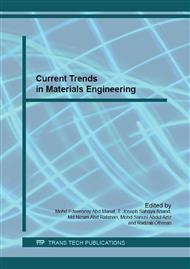p.3
p.8
p.13
p.18
p.23
p.29
p.34
p.39
Preliminary Study on the Mechanical Properties of Continuous Long Pineapple Leaf Fibre Reinforced PLA Biocomposites
Abstract:
This research work investigates the effect of using alkaline-treated continuous long pineapple leaf fibers (PALF) as reinforcement in bio-based poly lactic acid (PLA) polymer biocomposite. Alkaline treatment using NaOH solution was employed to improve the fiber-matrix adhesion, with the aim to enhance the mechanical properties of the biocomposites, in terms of its tensile and impact properties. In this study, both the plain PLA polymer and the PALF reinforced PLA biocomposites were prepared using compression moulding process. Thin films with nominal thickness of approximately 1 mm each were stacked in between continuous long PALF fibers prior to compression moulding via hot press machine to form biocomposites plate. Two types of mechanical testing were performed, i.e., tensile test (ASTM D3039) and impact test (ASTM D6110). Significant enhancements are observed when the plain PLA were reinforced with the PALF long fiber, with the biocomposites showing two times better the tensile strength and modulus, with the values of approximately 73.26 MPa in comparison to only about 34.85 MPa for the plain PLA and tensile modulus of approximately 2735.36 MPa in comparison to 1641.12 MPa for the plain PLA. The energy absorption of the biocomposites also showed promising results with a value of approximately 0.92 J/cm2 in comparison to only about 0.35 J/cm2 for the plain PLA. In addition, a scanning electron microscope (SEM) was used to scrutinize morphology of the PALF reinforced PLA biocomposites.
Info:
Periodical:
Pages:
18-22
Citation:
Online since:
May 2016
Keywords:
Price:
Сopyright:
© 2016 Trans Tech Publications Ltd. All Rights Reserved
Share:
Citation:


